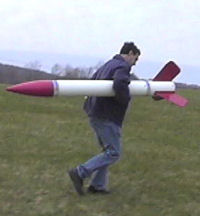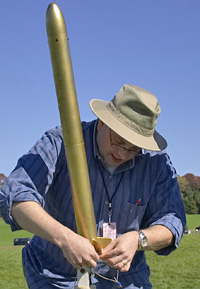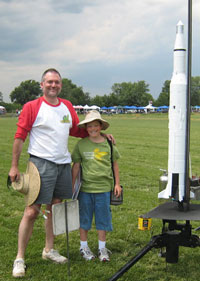- Posts: 14
- Thank you received: 0
Descent rate
- houston47d
-
 Topic Author
Topic Author
- Offline
- New Member
-

Less
More
13 years 5 months ago #4793
by houston47d
Descent rate was created by houston47d
Hello All,
Wow, what a great season of flying!
I\'ve setup my Aerotech Arreaux and my Mercury Hijacker for drogueless dual deployment based on an article in Apogee\'s Peak of Flight newsletter, issue #258. It allows dual deployment in a single compartment by restraining the main chute until released by the altimeter.
The descent rate from the altimeter data while separated but without a chute deployed was 35 ft/sec (Arreaux) and 41 ft/sec (Hijacker), dropping to about 20 ft/sec when the main chute opened (a bit fast - I haven\'t increased the size of the chute to compensate for the added weight of the altimeter and battery). I was hoping for a higher decent rate without the chute - something >60 ft/sec.
Is there anything I can do to increase the descent rate?
Thank you,
David
Wow, what a great season of flying!
I\'ve setup my Aerotech Arreaux and my Mercury Hijacker for drogueless dual deployment based on an article in Apogee\'s Peak of Flight newsletter, issue #258. It allows dual deployment in a single compartment by restraining the main chute until released by the altimeter.
The descent rate from the altimeter data while separated but without a chute deployed was 35 ft/sec (Arreaux) and 41 ft/sec (Hijacker), dropping to about 20 ft/sec when the main chute opened (a bit fast - I haven\'t increased the size of the chute to compensate for the added weight of the altimeter and battery). I was hoping for a higher decent rate without the chute - something >60 ft/sec.
Is there anything I can do to increase the descent rate?
Thank you,
David
Please Log in or Create an account to join the conversation.
- billspad
-

- Offline
- User is blocked
-

Less
More
- Posts: 632
- Thank you received: 0
13 years 5 months ago #4794
by billspad
Replied by billspad on topic Re:Descent rate
houston47d wrote:
You could make it heavier but that seems pointless. Other than that the only thing you can do is make it more streamlined in the direction it\'s traveling. You would need to keep all the parts in line with the nosecone pointing down.
I assume the Apogee dual deployment thing worked well both times. I\'ve had the article sitting on my desk for 6 months because it sounded like a good idea. Now that I know it works I think I\'ll give it a try.
Is there anything I can do to increase the descent rate?
You could make it heavier but that seems pointless. Other than that the only thing you can do is make it more streamlined in the direction it\'s traveling. You would need to keep all the parts in line with the nosecone pointing down.
I assume the Apogee dual deployment thing worked well both times. I\'ve had the article sitting on my desk for 6 months because it sounded like a good idea. Now that I know it works I think I\'ll give it a try.
Please Log in or Create an account to join the conversation.
- dlindbergh
-

- Offline
- Junior Member
-

Less
More
- Posts: 37
- Thank you received: 0
13 years 5 months ago #4795
by dlindbergh
You can delay the initial separation until a little before the main deployment.
If you do that, it\'ll descend streamlined (== FAST) until separation, then slow down abruptly to the new terminal velocity in the separated configuration.
THEN you can deploy the main.
I suggest you experiment a bit (with a logging altimeter) to see how long it takes to slow down, so you know how much in advance of the main you need to do the separation.
If your altimeter can\'t be set to do the initial separation anywhere other than apogee, then you\'ll need 2 altimeters - one for the initial separation (at, say, main altitude plus 300 feet), the other for the main.
Replied by dlindbergh on topic Re:Descent rate
Is there anything I can do to increase the descent rate?
You can delay the initial separation until a little before the main deployment.
If you do that, it\'ll descend streamlined (== FAST) until separation, then slow down abruptly to the new terminal velocity in the separated configuration.
THEN you can deploy the main.
I suggest you experiment a bit (with a logging altimeter) to see how long it takes to slow down, so you know how much in advance of the main you need to do the separation.
If your altimeter can\'t be set to do the initial separation anywhere other than apogee, then you\'ll need 2 altimeters - one for the initial separation (at, say, main altitude plus 300 feet), the other for the main.
Please Log in or Create an account to join the conversation.
- Boris Katan
-

- Offline
- Elite Member
-

Less
More
- Posts: 230
- Thank you received: 6
13 years 5 months ago #4796
by Boris Katan
Replied by Boris Katan on topic Re:Descent rate
How long and what diameter is your drogue-less recovery harness?
That harness and the tumbling nose cone are causing drag which lifts the front of the main body tube.
In this position the whole body plus the fins at the tail of the rocket cause a lot of drag.
A short and relatively thin drogue-less harness may allow for a more nose down, faster recovery. So would weight at the tip of the nose cone.
The problem with either of these approaches is that they would put the body tube in a downward position for main chute ejection.
Another possibility would be to put a small streamer at the base of the NC, just enough to put the rocket in a tail down position. It is possible that by adding a little drag at one end of the rocket, the whole rocket can be shifted to an orientation that has lower total drag.
If this can be made to work, a big benefit is the body opening facing up for main ejection.
That harness and the tumbling nose cone are causing drag which lifts the front of the main body tube.
In this position the whole body plus the fins at the tail of the rocket cause a lot of drag.
A short and relatively thin drogue-less harness may allow for a more nose down, faster recovery. So would weight at the tip of the nose cone.
The problem with either of these approaches is that they would put the body tube in a downward position for main chute ejection.
Another possibility would be to put a small streamer at the base of the NC, just enough to put the rocket in a tail down position. It is possible that by adding a little drag at one end of the rocket, the whole rocket can be shifted to an orientation that has lower total drag.
If this can be made to work, a big benefit is the body opening facing up for main ejection.
Please Log in or Create an account to join the conversation.
- billspad
-

- Offline
- User is blocked
-

Less
More
- Posts: 632
- Thank you received: 0
13 years 5 months ago #4798
by billspad
Replied by billspad on topic Re:Descent rate
dlindbergh wrote:
You can get a Raven to do a late deploy.
If your altimeter can\'t be set to do the initial separation anywhere other than apogee, then you\'ll need 2 altimeters - one for the initial separation (at, say, main altitude plus 300 feet), the other for the main.
You can get a Raven to do a late deploy.
Please Log in or Create an account to join the conversation.
- houston47d
-
 Topic Author
Topic Author
- Offline
- New Member
-

Less
More
- Posts: 14
- Thank you received: 0
13 years 5 months ago #4799
by houston47d
Replied by houston47d on topic Re:Descent rate
Hello All,
Thank you for the replies.
I am currently using the Perfectflight MAWD. The measured descent rate was from the logged data. In general, I have been pretty happy with it. My only real disappointment has been the 10\' resolution. The Raven looks interesting - I\'m going to keep that in mind when I look for another altimeter.
The recovery harness in both cases is 3/8\" elastic about 6 feet long. Also hanging out in the wind is the 5.5\" tube holding the main chute. The Arreaux separates into (about) a 22\" booster and a 21\" nose/payload section. The Hijacker into a 30\" booster and a 20\" nose/payload. In both cases, they seem to come down pretty flat.
In this case, the orientation of the body tube isn\'t an issue, as the main chute has already been pushed out and is simply being retained in a tube. Seems there are a couple of things to try. One is the streamer to orient the nose/payload section. I\'m guessing some small fins at the bottom of the payload section might have a similar effect (both rockets are _way_ overstable with the weight of the altimeter in the nose).
Not sure that I could handle the FAST descent - would have to start bringing a change of clothes to the launches . But I can see that it would make sense for extreme altitudes when the fastest possible descent is required and it can be slowed down with progressively draggier configurations.
. But I can see that it would make sense for extreme altitudes when the fastest possible descent is required and it can be slowed down with progressively draggier configurations.
I\'ve used this dual deployment approach three times now. At the last launch, the parachute worked its way out of the retainer tube, resulting in the long descent. But the release mechanism worked as intended. I am going to put a ring around the open end of the retainer for future flights. Been very happy with the results so far. Next year I\'ll start having the separation triggered at apogee by the altimeter.
Thanks for your help. Now I just have to wait for June to come around to give it a try.
David
Thank you for the replies.
I am currently using the Perfectflight MAWD. The measured descent rate was from the logged data. In general, I have been pretty happy with it. My only real disappointment has been the 10\' resolution. The Raven looks interesting - I\'m going to keep that in mind when I look for another altimeter.
The recovery harness in both cases is 3/8\" elastic about 6 feet long. Also hanging out in the wind is the 5.5\" tube holding the main chute. The Arreaux separates into (about) a 22\" booster and a 21\" nose/payload section. The Hijacker into a 30\" booster and a 20\" nose/payload. In both cases, they seem to come down pretty flat.
In this case, the orientation of the body tube isn\'t an issue, as the main chute has already been pushed out and is simply being retained in a tube. Seems there are a couple of things to try. One is the streamer to orient the nose/payload section. I\'m guessing some small fins at the bottom of the payload section might have a similar effect (both rockets are _way_ overstable with the weight of the altimeter in the nose).
Not sure that I could handle the FAST descent - would have to start bringing a change of clothes to the launches
I\'ve used this dual deployment approach three times now. At the last launch, the parachute worked its way out of the retainer tube, resulting in the long descent. But the release mechanism worked as intended. I am going to put a ring around the open end of the retainer for future flights. Been very happy with the results so far. Next year I\'ll start having the separation triggered at apogee by the altimeter.
Thanks for your help. Now I just have to wait for June to come around to give it a try.
David
Please Log in or Create an account to join the conversation.
